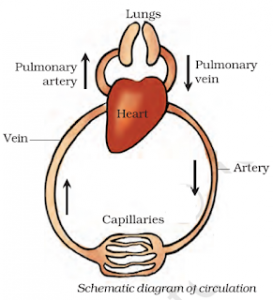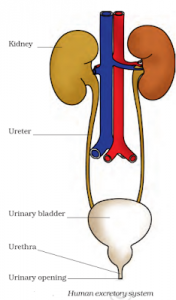Notes For All Chapters Science Class 7
Revision Notes of Ch 7 Transportation in Animals and Plants Class 7th Science
Topics in the chapter
Circulatory System
Blood
Lymph
Blood vessels
Heart
Excretory system
Transport in plants
Excretion in plants
Circulatory System
→ All multicellular organisms have a specialized system to transport nutrients and other necessary materials to the cell and the wastes away from the cell. This system is known as circulatory system.
→ Circulatory system is the transportation system of human body. It has three major parts:
(i) Blood
(ii) Blood vessel
(iii) Heart
Blood
→ It is a fluid connective tissue that is pumped throughout the body by heart.
Functions of Blood
→ It transports oxygen and nutrients to various parts of the body.
→ It also transports wastes for removal from the body.
Composition of Blood
→ It contains plasma, red blood cells, white blood cells, and platelets.
→ Plasma is the fluid part of blood.
→ Red blood cell contains a pigment called haemoglobin. It carries oxygen and transports it
to all parts of the body.
→ White blood cell protects body against infections. These are also known as leucocytes.
→ Platelets help in clotting of blood.
Lymph
→ Lymph is a watery clear fluid. It is blood minus RBC.
→ This fluid distributes immune cells and other factors throughout the body.
→ It also interacts with the blood circulatory system to drain fluid from cells and tissues.
→ The lymphatic system contains immune cells called lymphocytes, which protect the body against foreign antigens (viruses, bacteria, etc.) that invade the body.
Heart
→ It is the main pumping organ of our body that beats continuously.
→ It pumps oxygen-rich blood to all parts of the body and carbon dioxide-rich blood to the
lungs. .
→ Human heart is four chambered as shown in the figure below, and located in the chest
cavity.
→ The upper two chambers are called atria while lower two chambers are called ventricles.
→ A muscular wall between the chambers prevents the mixing up of blood rich in oxygen and blood rich in carbon dioxide.
→ The rhythmic contraction and expansion of heart is the heart beat.
→ Doctors use stethoscope for listening to the heart sounds.
→ The human heart beats about 70 to 80 times per minute in an adult.
Blood vessels
There are three types of blood vessels:
(i) Arteries
(ii) Veins
(iii) Capillaries
Arteries
→ Arteries carry oxygen-rich blood from the heart to various organs of the body.
→ Pulmonary artery is the only artery that carries CO2-rich blood from heart to lungs.
→ The walls of arteries are thick and elastic in order to tolerate high pressure of the blood.
→ Pulse is the rhythmic contraction and expansion of arteries with each beat of heart.
→ The number of beats per minute is the pulse rate.
→ A resting person usually has a pulse rate between 72 to 80 beats per minute.
Veins
→ Veins carry CO2-rich blood from various organs towards the heart.
→ They are thin-walled, non-elastic vessels that do not possess valves.
→ Pulmonary veins carry oxygen-rich blood from lungs to heart.
Capillaries
Capillaries are thin-walled blood vessels. They connect arteries with veins.
Excretory system
→ The organ system that performs the function of excretion is known as the excretory system.
Excretion
→ It is the process of removing harmful waste products produced in the cells of living organisms.
→ The excretory system in humans includes – a pair of kidneys, a pair of ureters, a urinary
bladder and a urethra.
Kidney
→ It is the main excretory organ of the human body.
→ It plays an important role in the formation of urine. Human kidney produces about 1 – 1.8L of urine in a day.
→ The urine consists of 95% water, 2.5% urea and 2.5% other waste products.
→ Nephrons are the basic filtering units of the kidneys.
→ The main components of a nephron are the glomerulus, Bowman’s capsule, and a long renal tube.
→ Ureter carries urine to the bladder.
→ Urinary bladder collects and stores urine.
→ Urethra carries urine out of the body.
→ Dialysis- The process of removing wastes using an artificial kidney is called dialysis.
Transport in plants
→ Plants have specialized vascular tissues called xylem and phloem for the transport of water, minerals and food respectively to all parts.
Transport of Water in Plants
→ Plant roots have hair that increase the surface area for absorption of water and minerals.
→ Root hair are deficient in water as they continuously supply the absorbed water to the
stems and leaves.
→ This creates a concentration gradient, which allows the active uptake of water by the root
xylem thereby creating a column of water, which steadily pushes upwards.
Transportation of food in Plants
→ Leaves prepare food for plant by the process called photosynthesis.
→ The prepared food is transported to remaining parts of the plants by a specialized vascular
tissue known as phloem.
→ The phloem forms a network of channels that transports food to the stem and to the roots of
the plant.
Excretion in plants
→ Plants get rid of the excess of water by transpiration.
→ In transpiration water evaporates into the atmosphere through stomata.
→ Stomata are the tiny openings or pores on the surface of leaves which help in the gaseous
exchange and transpiration.
NCERT Solutions of Transportation in Animals and Plants Class 7




Nice
evidyarthi is the ultimate all-rounder, offering the best chapter PDFs, solutions, lecture videos, multiple-choice questions, revision notes, important questions, examination sample papers, and practice of previous year question papers. It has been an invaluable resource for my classes—6th, 7th, 8th, 9th, 10th, 11th, and 12th. Through its help, I have significantly improved my understanding in subjects like Mathematics, Science, Sanskrit, Social Science, Hindi, and English. Thank you so much for creating such a wonderful platform! 😊😊